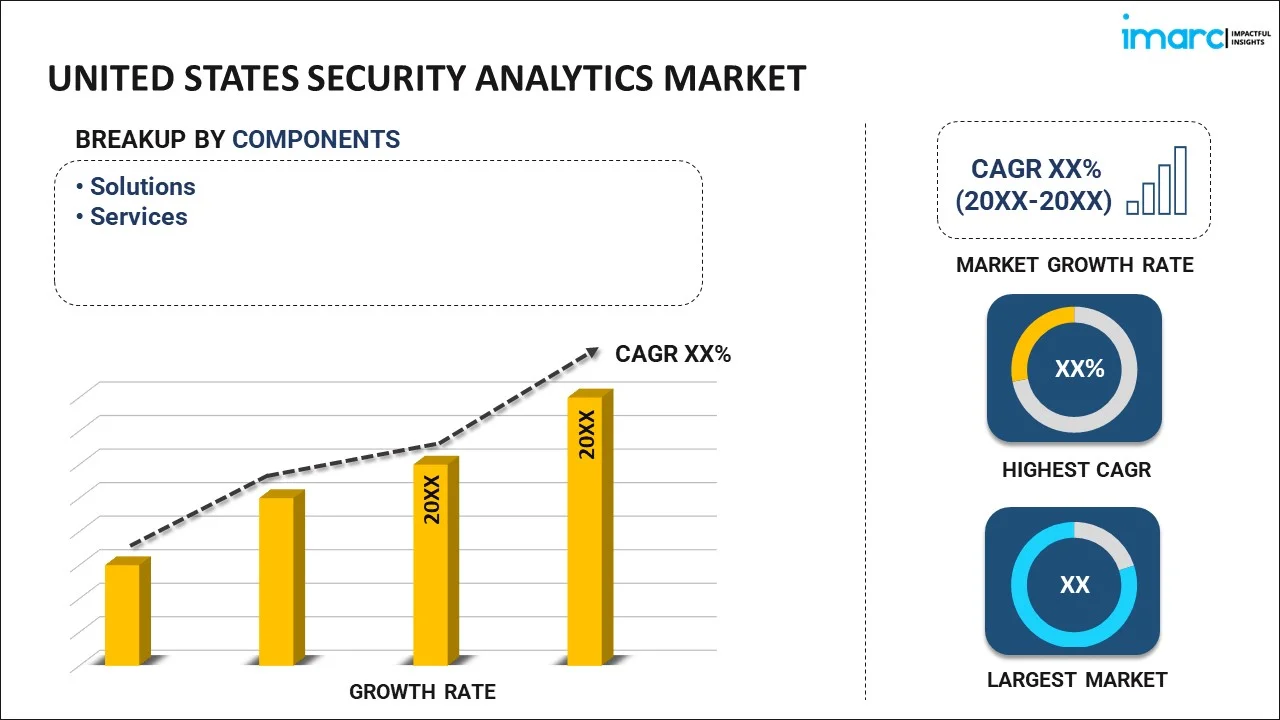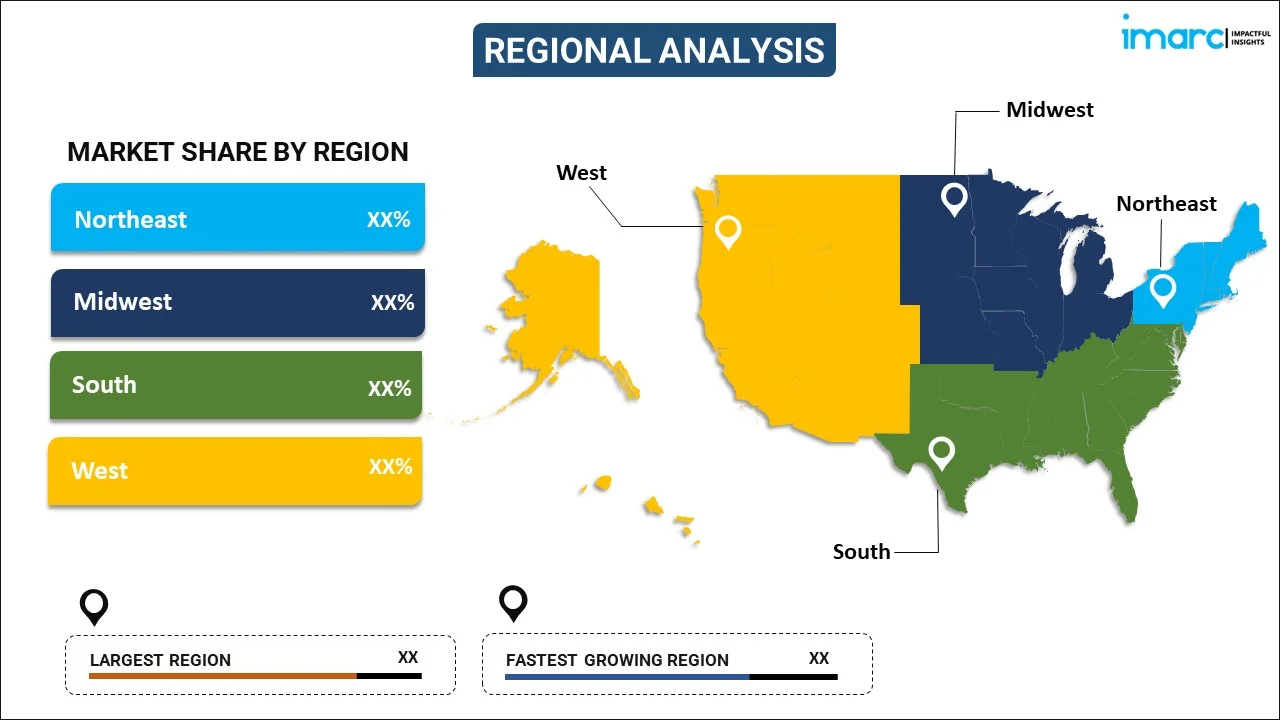
United States Security Analytics Market Report by Component (Solutions, Services), Application (Application Security Analytics, Web Security Analytics, Endpoint Security Analytics, Network Security Analytics, and Others), Deployment Mode (Cloud-based, On-premises), Organization Size (Small and Medium-sized Enterprises, Large Enterprises), Vertical (BFSI, Healthcare, Manufacturing, Consumer Goods and Retail, IT and Telecom, Government and Defense, and Others), and Region 2024-2032
Market Overview:
United States security analytics market size is projected to exhibit a growth rate (CAGR) of 14.70% during 2024-2032. The inflating need for fortifying the cybersecurity posture of organizations across sectors, including government and healthcare, is primarily driving the market growth across the country.
|
Report Attribute
|
Key Statistics
|
|---|---|
|
Base Year
|
2023 |
|
Forecast Years
|
2024-2032 |
|
Historical Years
|
2018-2023
|
| Market Growth Rate (2024-2032) | 14.70% |
Security analytics involves a proactive strategy that utilizes big data analytics and machine learning to collect, categorize, and analyze data from network devices. The main objective is to effectively manage the security of an organization's digital infrastructure and thwart advanced threats. This approach is rooted in data mining and threat detection algorithms designed to furnish analytical results related to digital asset metadata, geo-location, threat intelligence, and internet protocol (IP) context. Security analytics delivers real-time alerts sourced from various endpoints, such as workstations, servers, mobile devices, and sensors. Additionally, it monitors network traffic volume and integrates third-party threat intelligence feeds. The emphasis is on leveraging advanced analytical techniques to enhance the security posture of organizations and preemptively address potential security risks.
United States Security Analytics Market Trends:
The United States security analytics market represents a critical facet of the cybersecurity landscape, embodying a proactive strategy that leverages big data analytics and machine learning for robust threat detection and prevention. This market is pivotal in managing the security of digital infrastructures within organizations, focusing on averting advanced threats. Additionally, rooted in data mining and sophisticated threat detection algorithms, security analytics in the United States provides in-depth analytical insights related to digital asset metadata, geo-location, threat intelligence, and internet protocol (IP) context. Moreover, it operates by delivering real-time alerts sourced from a spectrum of endpoints, including workstations, servers, mobile devices, and sensors, which is acting as another significant growth-inducing factor. Furthermore, the United States security analytics market plays a crucial role in monitoring network traffic volume and integrating third-party threat intelligence feeds. As the digital landscape continues to evolve, the demand for advanced security solutions grows, positioning the U.S. security analytics market for sustained growth. Besides this, with a focus on preemptive security measures and leveraging cutting-edge analytics, this market is anticipated to fuel the market growth over the forecasted period.
United States Security Analytics Market Segmentation:
IMARC Group provides an analysis of the key trends in each segment of the market, along with forecasts at the country level for 2024-2032. Our report has categorized the market based on component, application, deployment mode, organization size, and vertical.
Component Insights:

- Solutions
- Services
- Professional Services
- Managed Services
The report has provided a detailed breakup and analysis of the market based on the component. This includes solutions and services (professional services and managed services).
Application Insights:
- Application Security Analytics
- Web Security Analytics
- Endpoint Security Analytics
- Network Security Analytics
- Others
A detailed breakup and analysis of the market based on the application have also been provided in the report. This includes application security analytics, web security analytics, endpoint security analytics, network security analytics, and others.
Deployment Mode Insights:
- Cloud-based
- On-premises
The report has provided a detailed breakup and analysis of the market based on the deployment mode. This includes cloud-based and on-premises.
Organization Size Insights:
- Small and Medium-sized Enterprises
- Large Enterprises
A detailed breakup and analysis of the market based on the organization size have also been provided in the report. This includes small and medium-sized enterprises and large enterprises.
Vertical Insights:
- BFSI
- Healthcare
- Manufacturing
- Consumer Goods and Retail
- IT and Telecom
- Government and Defense
- Others
The report has provided a detailed breakup and analysis of the market based on the vertical. This includes BFSI, healthcare, manufacturing, consumer goods and retail, IT and telecom, government and defense, and others.
Regional Insights:

- Northeast
- Midwest
- South
- West
The report has also provided a comprehensive analysis of all the major regional markets, which include Northeast, Midwest, South, and West.
Competitive Landscape:
The market research report has also provided a comprehensive analysis of the competitive landscape. Competitive analysis such as market structure, key player positioning, top winning strategies, competitive dashboard, and company evaluation quadrant has been covered in the report. Also, detailed profiles of all major companies have been provided.
United States Security Analytics Market Report Coverage:
| Report Features | Details |
|---|---|
| Base Year of the Analysis | 2023 |
| Historical Period | 2018-2023 |
| Forecast Period | 2024-2032 |
| Units | US$ Million |
| Scope of the Report | Exploration of Historical Trends and Market Outlook, Industry Catalysts and Challenges, Segment-Wise Historical and Future Market Assessment:
|
| Components Covered |
|
| Applications Covered | Application Security Analytics, Web Security Analytics, Endpoint Security Analytics, Network Security Analytics, Others |
| Deployment Modes Covered | Cloud-based, On-premises |
| Organization Sizes Covered | Small and Medium-sized Enterprises, Large Enterprises |
| Verticals Covered | BFSI, Healthcare, Manufacturing, Consumer Goods and Retail, IT and Telecom, Government and Defense, Others |
| Regions Covered | Northeast, Midwest, South, West |
| Customization Scope | 10% Free Customization |
| Report Price and Purchase Option | Single User License: US$ 3699 Five User License: US$ 4699 Corporate License: US$ 5699 |
| Post-Sale Analyst Support | 10-12 Weeks |
| Delivery Format | PDF and Excel through Email (We can also provide the editable version of the report in PPT/Word format on special request) |
Key Questions Answered in This Report:
- How has the United States security analytics market performed so far and how will it perform in the coming years?
- What has been the impact of COVID-19 on the United States security analytics market?
- What is the breakup of the United States security analytics market on the basis of component?
- What is the breakup of the United States security analytics market on the basis of application?
- What is the breakup of the United States security analytics market on the basis of deployment mode?
- What is the breakup of the United States security analytics market on the basis of organization size?
- What is the breakup of the United States security analytics market on the basis of vertical?
- What are the various stages in the value chain of the United States security analytics market?
- What are the key driving factors and challenges in the United States security analytics?
- What is the structure of the United States security analytics market and who are the key players?
- What is the degree of competition in the United States security analytics market?
Key Benefits for Stakeholders:
- IMARC’s industry report offers a comprehensive quantitative analysis of various market segments, historical and current market trends, market forecasts, and dynamics of the United States security analytics market from 2018-2032.
- The research report provides the latest information on the market drivers, challenges, and opportunities in the United States security analytics market.
- Porter's five forces analysis assist stakeholders in assessing the impact of new entrants, competitive rivalry, supplier power, buyer power, and the threat of substitution. It helps stakeholders to analyze the level of competition within the United States security analytics industry and its attractiveness.
- Competitive landscape allows stakeholders to understand their competitive environment and provides an insight into the current positions of key players in the market.
Need more help?
- Speak to our experienced analysts for insights on the current market scenarios.
- Include additional segments and countries to customize the report as per your requirement.
- Gain an unparalleled competitive advantage in your domain by understanding how to utilize the report and positively impacting your operations and revenue.
- For further assistance, please connect with our analysts.
 Inquire Before Buying
Inquire Before Buying
 Speak to an Analyst
Speak to an Analyst
 Request Brochure
Request Brochure
 Request Customization
Request Customization




.webp)




.webp)












